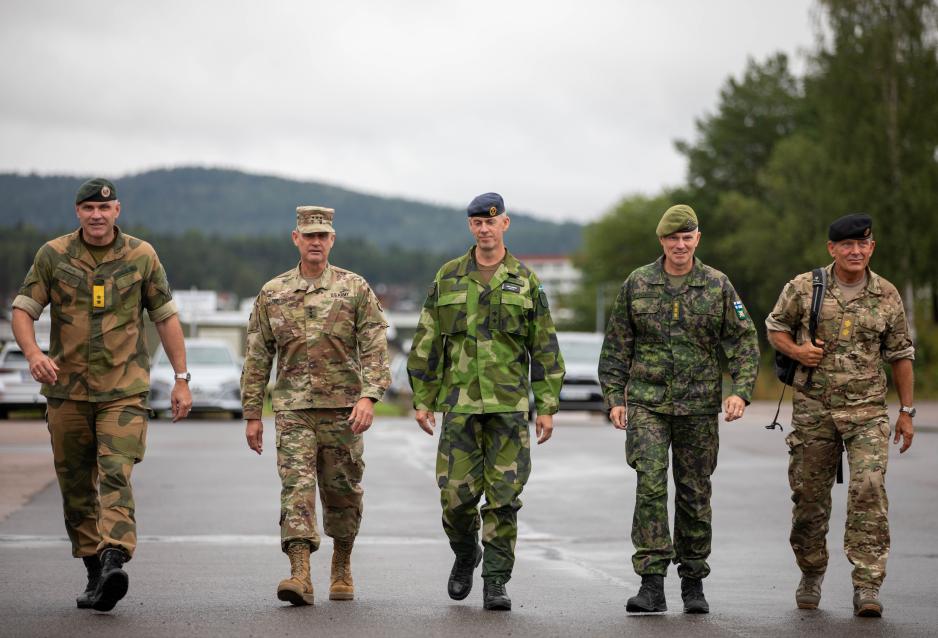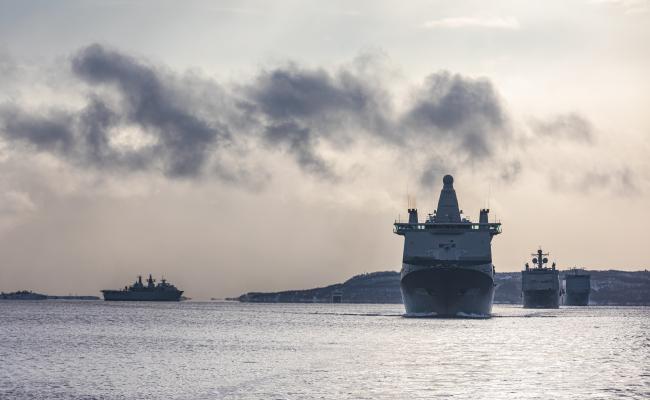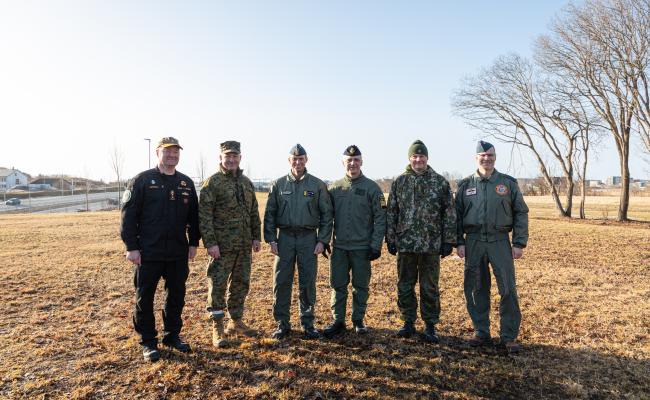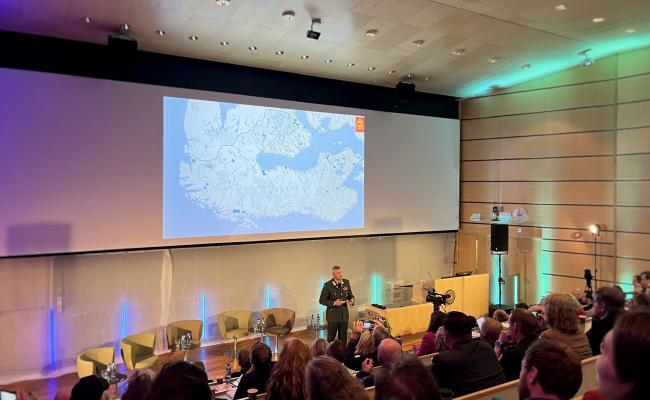Nordic and US Army Generals Discuss Plans for Nordic Defense

From the left: Norway's Army Chief Major General Lars Lervik; Commanding General of the US Army V Corps, Lt. General Charles Costanza; Chief of the Swedish Army, Major General Jonny Lindfors; Chief of the Finnish Army, Lt. General Pasi Välimaki, and the Commander of the Danish Army, Major General Peter Boysen. (Photo: Pfc. Richard Morgan / US Army).
Norwegian Army Military Academy, Oslo (High North News): Recently, the four Nordic Army Chiefs and the Commander of the US Army V Corps gathered to discuss the defense of the Cap of the North. "Norwegian, Finnish, Swedish, Danish, and US forces must be able to work together as seamlessly as possible," says Norway's Army Chief.
"With Sweden and Finland's accession to NATO, we have discussed how the four Nordic countries and the US would fight together. We have talked about how we would defend the Nordic countries," says US Army Lieutenant General Charles Costanza to High North News.
Costanza is the commanding general of US Army V Corps and speaks to HNN at the Norwegian Army Military Academy in connection with the Nordic Warfighter Symposium, which was organized with the US and the four Nordic countries Norway, Sweden, Finland, and Denmark for the first time this August.
During the seminar, the leadership of the US force presented their experiences and procedures for conducting large-scale combat operations. In short, this entails deploying larger military units, such as divisions or corps, in a conflict or war situation. V Corps is a massive military force that could lead such operations (see fact box).
The discussions have, therefore, revolved around what this would entail for the Nordic countries and what preparations are needed.
Lt. General Charles Costanza, Commanding General of the US Army V Corps. The corps was established in 1918 and was present in Europe during the First and Second World Wars, in addition to the Cold War. The unit was deactivated in 2013, but was re-activated in 2020, aiming to bolster European security. (Photo: Hilde Bye)
Nordic frameworks
The backdrop is how the Nordic region now is seen as one joint operational area after Finland and Sweden acceded to NATO, and what this entails with regards to planning and establishing prerequisites for conducting complex allied land operations.
When asked about large-scale combat operations in a Nordic context, Lt. Gen. Costanza points to fundamental conditions, such as operating in the Nordic terrain, as important aspects.
"The terrain differs notably from what we would see in Central Europe, such as Poland, which has a more open terrain This forces us to fight very differently. We talk about how we would fight here, and how the Nordic countries would fight here, based on the capabilities that we have. How we would communicate and work together is also central. Having such conversations here and learning from each other is very valuable," he adds.
Large-scale combat operations and the US Army V Corps
- Following the new focus on great power competiton between the US, Russia, and China, the US Army has seen a major transformation from focusing on counter-insurgency, such as in Afghanistan, to preparing for large-scale combat operations.
- These include using large military units in conflict or war, such as divisions and corps (the latter corresponds to two to five divisions, about 20,000 to 45,000 soldiers). Joint operations with allies and using all military capacities are also central.
- The United States V Corps is a massive military force of the United States Army that can lead such operations and has the only corps-level forward headquarters outside the United States, based in Poland.
"With the Nordic region as a joint operational area, the need to plan and conduct larger allied land and joint operations will increase. In the NATO alliance, the US has the greatest resources and the most experience with complex joint operations and projection of military power," writes the Norwegian Army Chief Lars Lervik in an op-ed in connection with the symposium. (Photo: Hilde Bye)
"In the time coming, we will not only think about defending Norway, but the Nordic region to a much greater extent. In this process, we must also plan how to organize when major operations will be conducted across bigger grounds and with more soldiers. One of the greatest challenges is precisely the great distances," says Chief of the Norwegian Army, Major General Lars Lervik, to HNN's journalist.
In operating with several forces, Norwegian, Finnish, Swedish, Danish, and American forces must be able to work together as seamlessly as possible, for example, says Lervik.
"Part of what we have discussed here is joint procedures and a shared language. We must have these things in place in times of peace and not when things get difficult," he adds.
Chief of the Finnish Army, Lt. General Pasi Välimäki, emphasizes the importance of coordination between the Nordic forces, as well as with other NATO allies. (Photo: Hilde Bye).
In the wake of the Nordic Response
The Commander of the Finnish Army Lt. General Pasi Välimäki points out that the symposium is a step forward from the military exercise Nordic Response in March this year, where allied forces trained to defend the Cap of the North.
"As an extension of the military exercise, we now look at processes and what we can improve. It is logical for us to see the area from the Gulf of Finland to the sea areas in the High North as one operational area that we have to look at together. We are discussing how we can better cooperate, plan, and develop our capacities," says Välimäki.
The conflict in the North sets other requirements.
"We are trying to better coordinate our countries' resources," says Sweden's Army Chief Major General Jonny Lindfors to High North News. (Photo: Hilde Bye)
New brigades for the sub-Arctic environments
"Some of those who are furthest ahead with resources and training in large-scale combat operations are the US Army V Corps. As smaller nations, we have a lot to learn from them. At the same time, the Nordics are also growing in strength," says Sweden's Army Chief, Major General Jonny Lindfors.
Lindfors particularly highlights the four Nordic countries' latest long-term plans for the defense sector, and their focus on bolstering the armies.
According to the new Norwegian long-term plan for the Armed Forces, the land force will be strengthened and restructured. This includes, among other things, developing the Army from one to three brigades: one in Finnmark, one in Troms, and a new Brigade South. Additionally, by 2030 Brigade Nord should also be completed as a heavy infantry brigade with four mechanized battalions and support units.
What does the Swedish Army's focus on the High North look like?
"In connection with the upcoming defense decision [corresponding long-term plan for the Armed Forces, ed. note] and the proposal we will soon receive from our government, I have suggested that we design two of our brigades specifically for operations in sub-Arctic environments," says the Swedish army chief.
According to him, these two brigades are to be mechanized brigades. The difference from the current structure is, among other things, more tracked vehicles and fewer wheeled vehicles.
"The conflict in the North sets other requirements. There are few road connections, and you need off-road mobility," he sums up.
"As far as Norway, Sweden, and Finland are concerned, we have a joint area in the North that we must be able to defend, and we need to be as coordinated as possible. We practiced this during Nordic Response this winter and look forward to continuing to practice the actual defense plans and how to defend ourselves," Lindfors concludes.





